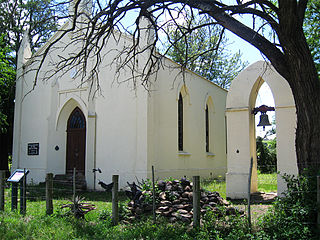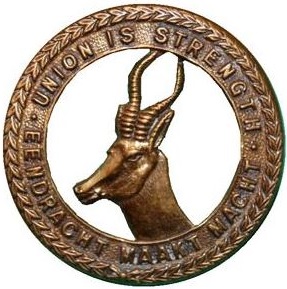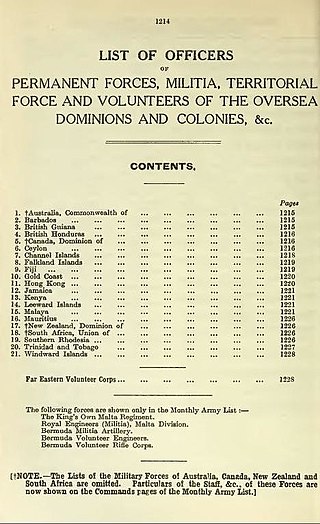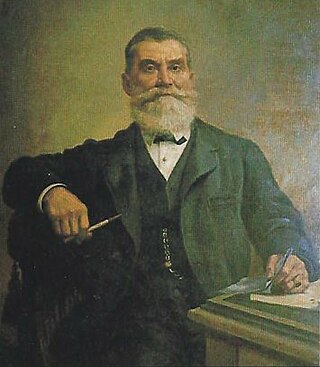
The French Foreign Legion is a corps of the French Army that consists of several specialties: infantry, cavalry, engineers, airborne troops. It was created in 1831 to allow foreign nationals into the French Army. It formed part of the Armée d’Afrique, the French Army's units associated with France's colonial project in Northern Africa, until the end of the Algerian war in 1962.

The King's African Rifles (KAR) was a British Colonial Auxiliary Forces regiment raised from Britain's East African colonies in 1902. It primarily carried out internal security duties within these colonies along with military service elsewhere during the world wars and other conflicts, such as the Malayan Emergency and the Mau Mau uprising. The regiment's enlisted soldiers were drawn from the native Africans, while most officers were seconded from the British Army. During the 1960s, as part of the decolonisation of Africa, more African officers were commissioned into the regiment before it was gradually disbanded. KAR battalions would go on to form the core of newly established armed forces throughout East Africa.

The Swiss mercenaries were a powerful infantry force constituted by professional soldiers originating from the cantons of the Old Swiss Confederacy. They were notable for their service in foreign armies, especially among the military forces of the kings of France, throughout the early modern period of European history, from the Late Middle Ages into the Renaissance. Their service as mercenaries was at its peak during the Renaissance, when their proven battlefield capabilities made them sought-after mercenary troops. There followed a period of decline, as technological and organizational advances counteracted the Swiss' advantages. Switzerland's military isolationism largely put an end to organized mercenary activity; the principal remnant of the practice is the Pontifical Swiss Guard at the Vatican.

The King's German Legion was a British Army unit of mostly expatriated German personnel during the period 1803–16. The legion achieved the distinction of being the only German force to fight without interruption against the French during the Napoleonic Wars.

Stutterheim is a town with a population of 46,730 in South Africa, situated in the Border region of the Eastern Cape province. It is named after Richard Von Stutterheim.

The General Jan Smuts Regiment is a reserve mechanised infantry regiment of the South African Army.

The Johannesburg Light Horse Regiment, is a reserve armoured car reconnaissance unit of the South African Army.

Colonial troops or colonial army refers to various military units recruited from, or used as garrison troops in, colonial territories.
The Cape Mounted Riflemen were South African military units.

The South African Overseas Expeditionary Force (SAOEF) was a volunteer military organisation in World War I.

The Indian Legion, officially the Free India Legion or 950th (Indian) Infantry Regiment, was a military unit raised during the Second World War initially as part of the German Army and later the Waffen-SS from August 1944. Intended to serve as a liberation force for British-ruled India, it was made up of Indian prisoners of war and expatriates in Europe. Due to its origins in the Indian independence movement, it was known also as the "Tiger Legion", and the "Azad Hind Fauj". As part of the Waffen-SS it was known as the Indian Volunteer Legion of the Waffen-SS.
The military history of South Africa chronicles a vast time period and complex events from the dawn of history until the present time. It covers civil wars and wars of aggression and of self-defence both within South Africa and against it. It includes the history of battles fought in the territories of modern South Africa in neighbouring territories, in both world wars and in modern international conflicts.

The Foreign Legion has had a long and unique history amongst the units of the French Army. It was historically formed of expatriate enlisted personnel led by French officers. Founded by a royal ordinance issued by King Louis Philippe of France on March 9, 1831, with aim of bolstering the strength of the French Army while also finding a use for the influx of refugees inundating France at the time. The Foreign Legion subsequently found a permanent home in the ranks of the French military. The Foreign Legion's history spans across Conquest of Algeria, the Franco-Prussian War, numerous colonial exploits, both World Wars, the First Indochina War, and the Algerian War.

The British Colonial Auxiliary Forces were the various military forces of Britain's colonial empire which were not considered part of the British military proper.

Caesar Carl Wilhelm Hans Henkel, was a German-born South African forester, cartographer, painter, soldier and botanist. He was the father of John Spurgeon Henkel.

Baron Richard Carl Gustav Ludwig Wilhelm Julius von Stutterheim was a Prussian – later also British – officer and commander of the British-German Legion.

Captain Carl von Brandis was a cavalry officer in Austrian and British service, and later a mining commissioner and landdrost (magistrate) in the South African Republic (Transvaal). He is most commonly known for being the Witwatersrand's first mining commissioner and Johannesburg's first landdrost.















